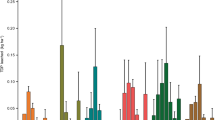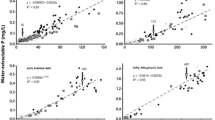Abstract
Phosphorus (P) loss from urban areas has been identified as a major contributor to declining surface water quality. The objective of this study was to determine the relationship between extractable soil P, depth of soil sampling, and dissolved reactive P (DP) concentration in runoff from turfgrass areas. At each site, runoff was generated on turfgrass and adjoining areas where turfgrass cover was removed. Across all six locations and the wide range of nutrient management schemes, variation of extractable soil P concentration and saturation ratios of 0–2cm samples accounted for 49–59% (r 2 = 0.49–0.59, n = 92) of variation of DP concentration in runoff from bare soil and soil with turfgrass cover. Despite a high degree of soil P stratification, changing sampling depth generally did not improve the relationship between soil test P and runoff DP concentrations. Across the narrower range of soil P levels common to lawns in New York (0–50mg kg−1 Morgan extractable soil P), none of the soil tests or P saturation levels (for 0–2cm depth) could accurately predict runoff P concentrations from soil with turfgrass cover (r 2 = 0.02 to 0.23, n = 72). For bare soil plots, restricting the analysis to the same range (<50mg kg−1 Morgan extractable P) did not alter the relationship between soil test P and runoff DP concentrations observed for the entire range (0–658mg kg−1) of soil-test P concentrations. These results suggest soil testing will not be an effective tool to predict runoff from turfgrass areas across the range of soil P levels common to New York State.





Similar content being viewed by others
References
Andraski, T. W., & Bundy, L. G. (2003). Relationships between phosphorus levels in soil and in runoff from corn productions systems. Journal of Environmental Quality, 32, 310–316.
Augustin, B. (2007). Perception vs. Reality: How much nitrogen do homeowners put on their lawn? In Annual Meeting Abstracts [CD-ROM]. ASA, CSSA, and SSSA. Madison, WI.
Breeuwsma, A., & Silva, S. (1992). Phosphorus fertilisation and environmental effects in the Netherlands and the Po Region (Italy). The Winand Staring Centre for Integrated Land, Soil and Water Research, Wageningen.
Brock, E. H., Ketterings, Q. M., & Kleinman, P. J. A. (2007). Measuring and predicting the phosphorus sorption capacity of manure-amended soils. Soil Science, 172, 266–278. doi:10.1097/ss.0b013e318032ab2e.
Correll, D. L. (1998). The role of phosphorus in the eutrophication of receiving waters: a Review. Journal of Environmental Quality, 27, 261–266.
Daly, K., & Casey, A. (2005). Environmental aspects of soil phosphorus testing. Irish Journal of Agricultural and Food Research, 44, 261–279.
Easton, Z. M., & Petrovic, A. M. (2004). Fertilizer source effect on ground and surface water quality in drainage from turfgrass. Journal of Environmental Quality, 33, 645–655.
Foy, R. H. (2005). The return of the phosphorus paradigm. In J. T. Sims, & A. N. Sharpley (Eds.), Phosphorus: Agriculture and the environment. Agron. Monogr. 46 (pp. 911–939). Madison, WI: ASA, CSSA, SSSA.
Gburek, W. J., & Sharpley, A. N. (1998). Hydrologic controls on phosphorus loss from upland agricultural watersheds. Journal of Environmental Quality, 27, 267–277.
Gee, G. W., & Or, D. (2002). Particle-size analysis. In J. H. Dane, & G. C. Topp (Eds.), Methods of soil analysis. Part 4—physical methods (pp. 272–278). Madison, WI: ASA, CSSA, SSSA.
Gross, C. M., Angle, J. S., & Welterien, M. S. (1990). Nutrient and sediment losses from turfgrass. Journal of Environmental Quality, 19, 663–668.
Hartikainen, H. (1982). Water soluble phosphorus in Finnish mineral soils and its dependence on soil properties. Journal of the Scientific Agricultural Society of Finland, 54, 89–98.
Kleinman, P. J. A., Bryant, R. B., Reid, W. S., Sharpley, A. N., & Pimentel, D. (2000). Using soil phosphorus behavior to identify environmental thresholds. Soil Science, 165, 943–950. doi:10.1097/00010694-200012000-00004.
Kleinman, P. J. A., & Sharpley, A. N. (2002). Estimating soil phosphorus sorption saturation from Mehlich-3 data. Communications in Soil Science and Plant Analysis, 33, 1825–1839. doi:10.1081/CSS-120004825.
Kleinman, P. J. A., Sharpley, A. N., Veith, T. L., Maguire, R. O., & Vadas, P. A. (2004). Evaluation of phosphorus transport in surface runoff from packed soil boxes. Journal of Environmental Quality, 33, 1413–1423.
Maguire, R. O., & Sims, J. T. (2002). Measuring agronomic and environmental soil phosphorus saturation and predicting phosphorus leaching with Mehlich 3. Soil Science Society of America Journal, 66, 2033–2039.
McDowell, R. W., & Sharpley, A. N. (2001). Approximating phosphorus release from soils to surface runoff and subsurface drainage. Journal of Environmental Quality, 30, 508–520.
Mehlich, A. (1984). Mehlich III soil test extractant: a modification of Mehlich II extractant. Communications in Soil Science and Plant Analysis, 15, 1409–1416.
Milesi, C., Running, S. W., Elvidge, C. D., Dietz, J. B., Tuttle, B. T., & Nemani, R. R. (2005). Mapping and modeling the biogeochemical cycling of turf grasses in the United States. Environmental Management, 36, 426–438. doi:10.1007/s00267-004-0316-2.
Morgan, M. F. (1941). Chemical soil diagnosis by the universal soil testing system, Connecticut Agricultural Experimental Station Bulletin 450.
Murphy, J., & Riley, J. P. (1962). A modified single solution method for the determination of phosphate in natural waters. Analytica Chimica Acta, 27, 31–36. doi:10.1016/S0003-2670(00)88444-5.
Nair, P. S., Logan, T. J., Sharpley, A. N., Sommers, L. E., Tabatabai, M. A., & Yuan, T. L. (1984). Interlaboratory comparison of a standardized phosphorus adsorption procedure. Journal of Environmental Quality, 13, 591–595.
Nelson, D. W., & Sommers, L. E. (1996). Total carbon, organic carbon, and organic matter. In D. L Sparks, et al. (Ed.), Methods of soil analysis. Part 3—chemical methods (pp. 961–1010). Madison, WI: ASA, CSSA, SSSA.
Ogden, C. B., van Es, H. M., & Schindelbeck, R. R. (1997). Miniature rain simulator for field measurement of soil infiltration. Soil Science Society of America Journal, 61, 1041–1043.
Olsen, S. R., & Sommers, L. E. (1982). Phosphorus. In A. L. Page, et al. (Ed.), Methods of soil analysis. Part 2, Agron. Monogr. 9 (pp. 403–430, 2nd ed.). Madison, WI: ASA and SSSA.
Paul, M. J., & Meyer, J. L. (2001). Streams in the urban landscape. Annual Review of Ecology and Systematics, 32, 333–365. doi:10.1146/annurev.ecolsys.32.081501.114040.
Petrovic, A. M., Soldat, D., Gruttadaurio, J., & Barlow, J. (2005). Turfgrass growth and quality related to soil and tissue nutrient content. International Turfgrass Society Research Journal, 10, 989–997.
Pierson, S. T., Cabrera, M. L., Evanylo, G. K., Kuykendall, H. A., Hoveland, C. S., McCann, M. A., et al. (2001). Phosphorus and ammonia concentration in surface runoff from grasslands fertilized with broiler litter. Journal of Environmental Quality, 30, 1784–1789.
Pote, D. H., Daniel, T. C., Nichols, D. J., Sharpley, A. N., Moore Jr, P. A., Miller, D. M., et al. (1999). Relationship between phosphorus levels in three Ultisols and phosphorus concentrations in runoff. Journal of Environmental Quality, 28, 170–175.
Roberson, T., Bundy, L. G., & Andraski, T. W. (2007). Freezing and drying effects on potential plant contributions to phosphorus in runoff. Journal of Environmental Quality, 36, 532–539. doi:10.2134/jeq2006.0169.
Schroeder, P. D., Radcliffe, D. E., Cabrera, M. L., & Belew, C. D. (2004). Relationship between soil test phosphorus and phosphorus in runoff: Effects of soil series variability. Journal of Environmental Quality, 33, 1452–1463.
Sharpley, A. N. (1981). The contribution of phosphorus leached from crop canopy to losses in surface runoff. Journal of Environmental Quality, 10, 160–165.
Sharpley, A. N. (1993). Assessing phosphorus bioavailability in agricultural soils and runoff. Fertilizer Research, 36, 259–272. doi:10.1007/BF00748704.
Sharpley, A. N. (1995). Dependence of runoff phosphorus on extractable soil phosphorus. Journal of Environmental Quality, 24, 920−926.
Sharpley, A. N., Kleinman, P. J. A., McDowell, R. W., Gitau, M., & Bryant, R. B. (2001). Modeling phosphorus transport in agricultural watersheds: Processes and possibilities. Journal of Soil and Water Conservation, 57, 425−439.
Shuman, L. M. (2004). Runoff of nitrate nitrogen and phosphorus from turfgrass after watering-in. Communications in Soil Science and Plant Analysis, 35, 9–24. doi:10.1081/CSS-120027631.
Sims, J. T., Maguire, R. O., Leytem, A. B., Gartley, K. L., & Pautler, M. C. (2002). Evaluation of Mehlich 3 as an agri-environmental soil phosphorus test for the Mid-Atlantic United States of America. Soil Science Society of America Journal, 66, 2016–2032.
Sims, J. T., & Sharpley, A. N. (2005). Phosphorus: Agriculture and the environment. Agron. Monogr. 46. ASA, CSSA, SSSA: Madison, WI.
Soldat, D. J., Petrovic, A. M. (2007). Soil phosphorus levels and stratification as affected by fertilizer and compost applications. Online. Applied Turfgrass Science. doi:10.1094/ATS-2007-0815-01-RS.
Soldat, D. J., Rao, R., & Petrovic, A. M. (2005). Summary of soil test phosphorus results from home lawns and athletic fields in New York State: 2001–2005, In Annual Meeting Abstracts [CD-ROM]. Madison, WI: ASA, CSSA, and SSSA.
USEPA (United States Environmental Protection Agency) (2002). National water quality inventory 2000 report to congress, EPA-F-00-005. Washington DC: Office of Water.
Author information
Authors and Affiliations
Corresponding author
Rights and permissions
About this article
Cite this article
Soldat, D.J., Petrovic, A.M. & Ketterings, Q.M. Effect of Soil Phosphorus Levels on Phosphorus Runoff Concentrations from Turfgrass. Water Air Soil Pollut 199, 33–44 (2009). https://doi.org/10.1007/s11270-008-9857-y
Received:
Accepted:
Published:
Issue Date:
DOI: https://doi.org/10.1007/s11270-008-9857-y




